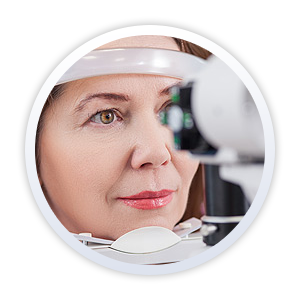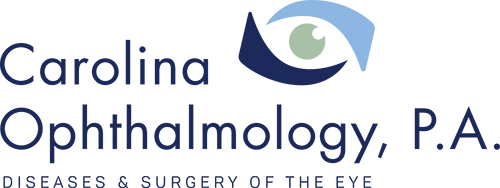What is Macular Degeneration?
The retina in the eye is like the film in a camera, that is, unless the retina functions well, the eye is unable to see properly even though the remainder of the eye may be in excellent health. The macula is that part of the retina that has a much greater ability to see than the rest of the retina. It is the area in the retina that gives us our 20/20 vision. Although the macula is the part of the retina that gives us our best vision, it is also that part of the retina that has the greatest demand for nutrients. With aging, the macula begins to degenerate to a certain extent and the person then cannot see as well as previously. Thinning of the macula can occur, and in some cases bleeding, which can lead to the inability to see fine details and if untreated, could ultimately result in blindness. These effects are seen in the photos below with normal vision on the left and an eye affected by macular degeneration on the right.

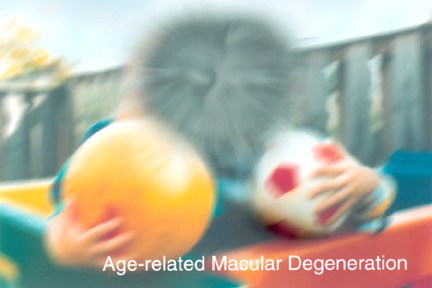
*Photos courtesy of National Eye Institute, National Institutes of Health
Again, let us use the analogy of the film in a camera. If the film is not working well we get a poor picture transmitted to our brain from our eye. Macular degeneration, also known as age-related macular degeneration (ARMD), is characterized by a loss of function in the portion of the eye responsible for central vision. Because central vision makes possible the detailed sight required for activities such as reading, driving and recognizing faces, macular degeneration may significantly diminish the ability to function independently in individuals who suffer from this disease. While some forms of macular degeneration result from hereditary diseases, most cases occur as part of the aging process.
Is there more than one kind of macular degeneration?
Macular degeneration is typically classified as the “wet” or “dry” form. All cases of ARMD begin as the dry form. For unknown reasons, approximately 10-20 % of these cases progress to the wet form. Dry macular degeneration is the more common and initially less serious type of the disease. It is often defined by tiny, white hyaline deposits called drusen that form under the retina. Dry macular degeneration can progress to become more serious over time. In dry AMD, as the waste products build up, retinal cells near the drusen begin to die, leading to a loss of function in that area of the retina. In some cases, a large area of cells will die, creating a blind spot in the central vision.
Approximately one in seven patients with dry macular degeneration will develop the wet form. Wet macular degeneration is the more serious type where abnormal and leaky blood vessels grow under the retina. These blood vessels leak fluid and blood, further disturbing macular function and leading to central vision loss. Wet AMD progresses more rapidly, and approximately 85 percent of affected individuals will advance to loss of central vision and be deemed legally blind. Wet macular degeneration is the most common cause of decreased vision after the age of 60.
What is the Amsler Grid Test?
This test can be administered at home and is one of the simplest and most effective ways for patients to monitor the health of their macula. By fixating the eyes on a single black dot superimposed on a series of intersecting lines (the Amsler Grid), those with normal vision will see straight, evenly spaced lines around the dot with no missing, curvy or irregularities in the lines. Those with disease affecting their macula will likely see wavy, bent, distorted or even missing sections of lines. Below is an example of a normal Amsler Grid pattern and an abnormal pattern, as in the case of macular degeneration.
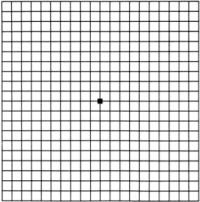
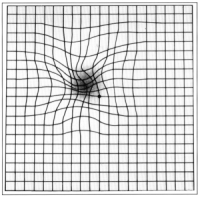
*Photos courtesy of National Eye Institute, National Institutes of Health
How is macular degeneration treated?
For most people, there is limited treatment for this condition. Recent advances in drug therapy have shown great promise in the treatment of ARMD, including the introduction of Lucentis. Some cases of ARMD also respond to treatment by laser.
If you have been told that you have macular degeneration, you should see a retinal surgeon specially trained in this area to determine of your condition is stable, as well as if you would benefit by treatment with the laser or other treatment modalities.
What can I do to prevent macular degeneration if it runs in my family?
Unfortunately, many people are genetically predisposed to macular degeneration and currently, it is not a preventable disease. Research has shown that several protective measures may delay the onset or lessen the severity of macular degeneration. Healthy habits that are started young will likely provide the most benefits. Recommendations include stopping smoking, wearing 100% UV-protection sunglasses and a hat when in the sun, controlling high blood pressure, cholesterol, diabetes and heart disease, taking daily multi-vitamins that include lutein, and eating a balanced diet rich in dark green leafy vegetables, sweet potatoes, blueberries, strawberries, and cold water fish such as salmon, tuna, mackeral and sardines. All these measures should be combined with regular, dilated eye exams with your ophthalmologist.
For more information, please consult the following fact sheet:
